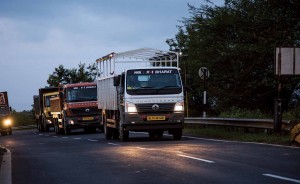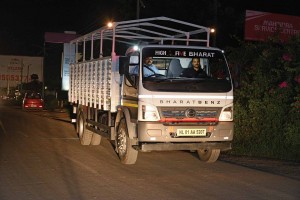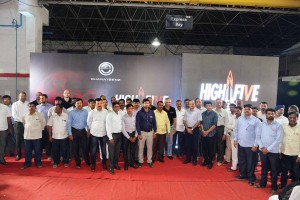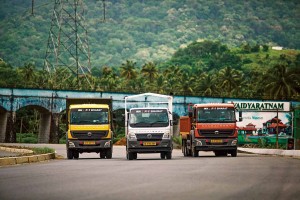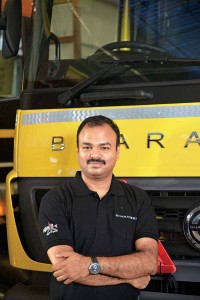Three BharatBenz trucks ran from Chennai to Ludhiana and back via Kolkata and Vijaywada to celebrate the five years of Daimler India Commercial Vehicles.
Story by:
Bhushan Mhapralkar
Photos:
Mahesh Reddy & DICV
It is past midnight as the convoy of three trucks gets on the highway to Mumbai. It is part of an initiative by Daimler India Commercial Vehicles (DICV) to celebrate five years of its journey in India. Starting from the DICV plant at Oragadam on the outskirts of Chennai on August 22, 2017, the convoy, under the ‘High Five’ campaign, will cover 19 major cities across India. Comprising of BharatBenz 1214, BharatBenz 2523, and BharatBenz 3123, the convoy will travel over a distance of 8000 km in one month. It will stop at dealerships, dhabas, and transport nagars, highlighting the advantages of a BharatBenz truck. I have travelled to Pune to join the convoy. Pune is one of the 50 stops the campaign will take during its journey. I have been given the opportunity to drive one of the three trucks as the campaign travels from Pune to Mumbai. Travelling with me is Rajaram Krishnanmurthy, Vice President, Daimler India Commercial Vehicles.
High Five
There is good amount of traffic as we hit the Pune By-Pass, rolling out of the Ghatge Trucking BharatBenz dealership. The By-pass will lead us to the Mumbai-Pune Expressway. To my surprise, the BharatBenz 1214 that I am at the wheel of, is easier to pilot than I had expected earlier. A modern truck, it is ergonomically arranged. My thoughts take me back in time to the day I drove a similar camoflauged truck at Hyderabad in 2012. When I tell this to Rajaram, he responds, “The Indian trucks have made a positive impression in Africa. The chances of a truck driver returning safe from the journey are full if he drives a truck made by Daimler in India.” His words surprise me. It takes a while before they sink in. It is silence for a few moments before he speaks: “In Africa, the terrain is so harsh that only the tough survive. If a truck breaks down during a journey, the safety of the crew is at risk.” Marketing and selling Indian made Daimler trucks in Africa for a good three to four years, Rajaram came to observe that many African markets do not have any emission norms. There are some markets, he mentions, where the competition includes used trucks sourced from Europe. Hinting at Indian Daimler trucks driving a change in Africa, Rajaram announces, “Much has changed in India over the years that I was in Africa.”
“Three years back when I left, the growth of the company was different. Now it is different. With BSIV emission norms coming in, and with technology by our side, a big change that I have come to observe is that customers are listening to technology. When I left for the international markets, it was about price. It was about the offer. Today, the same people are talking about technology,” he says. Referring to the ‘High Five’ campaign, Rajaram avers, “We want to celebrate the fifth anniversary of BharatBenz with more than 50,000 trucks on road. We want to involve our customers, drivers and partners. We want to thank them for trusting our brand and our products.” My thoughts are drawn to an event at Mumbai in 2012 when the BharatBenz HDT truck provided an insight into what a BharatBenz truck is like. It provided an insight into the technology that was leveraged from Daimler operations the world over. During the Hyderabad event, an engineer informed me that the cab suspension was based on a design found on Daimler’s Latin American trucks. As I tell this to Rajaram, he reveals,“ We will soon start rolling out Freightiner brand of trucks at Chennai for export to Latin American markets.” On the same line at Chennai are produced the BharatBenz, Fuso and Mercedes-Benz brand of trucks. “The Indian customer gets the same quality of truck that a Mercedes-Benz truck customer gets in an export market,” says Rajaram. “We export Mercedes-Benz trucks to the Indonesian market, and the Freightliner trucks will be exported to Latin American markets,” he explains.
Made in India
As he unveiled the BharatBenz HDT truck in 2102, Marc Llistosella, the then CEO and MD of DICV, announced that it was based on the Mercedes-Benz Axor platform. “We spent six years without any return, and now is the time,” he said. We indulged in extensive testing; we built a test track at our facility. We tested each and every component; tested everything. We tested for three long years. We gathered unique knowledge. We went after hardware engineering. Not very fancy, but innovative,” informed Llistosella. When I mention this to Rajaram, he avers, “the buyer was interested in price when we tried conveying technology during the move up to BSIII emission norms. He asked us about price, and about the discount. The same buyer today is asking about technology.”
Not much sound is entering the cabin. Our conversation poses no hurdles. Passing through the cities of Salem, Coimbatore, Kochi and Bangalore, the High-Five campaign stopover at Pune saw Rajaram and Satish Ghatge (the proprietor of Ghatge Trucking) hand over five spanking new BharatBenz trucks to their respective buyers. The ceremony saw BharatBenz owners drive to the dealership to interact with Rajaram and his team; with the dealer and his team. Some are into long-haul business, and some are into the construction business. They expressed that they are happy about their decision to purchase a BharatBenz truck because it is reliable and efficient.
The Expressway
The convoy rolls down the Expressway, and it is clocking good speeds. Says Rajaram, “The abolision of barriers due to GST entails a smooth drive for a truck. It can now travel more kilometers. Drivers can drive for more time, and over longer distances.” “It is under these circumstances that the comfort factor assumes importance,” he quips. The sale of fully-built cabin is rising according to Rajaram. My thoughts go to Eric Nesselhauf, MD & CEO, DICV, announce that they will offer fully built trucks only. It was on the eve of the first truck rolling out of the assembly line at Chennai. When I mention this to Rajaram, he quickly responds, “We have observed that speeds have multiplied since April. A truck that was averaging 30 kmph is now averaging 55 kmph. A truck often runs for 70 to 80 kms at a stretch with an average speed of 55 kmph. Since the truck is driving at high speeds, it has to have a safe cabin.” “With SCR technology, there is a reduction in overall costs. To increase operator profitability, we look at cutting costs. We are the only manufacturer that did not increase the cost of the truck after migration to BSIV,” he explains. The decision has led to DICV gaining traction opines Rajaram. He explains that the assembly lines are running full; seven days a week. “We are addressing the issue of a waiting period of four to six weeks,” he quips.
The journey
We cross the Talegaon toll post. The ‘High-Five’ campaign stickers on the door are attracting attention. Once past the toll plaza, it does not take long to regain good speeds. Speeds in the region of 60-80 kmph provide a glimpse of how modern and capable this truck is becoming. There’s no hint of fatigue. If the power steering is making it easy to maneouvre, the ample glass area and the wide mirrors are providing a good view of the surrounding. Pointing at the instrument panel, Rajaram opines, “The driver has to have comfort if he is to drive for more than 300 kms.” “Revenue will come by driving more, and driving longer distances. By doing more trips,” he avers. Informing that every third truck sold by DICV is air-conditioned, Rajaram states, “A gazette notification came out last week, which mandates a ventilation system or an AC. We are pushing for an AC cabin because they are the best for Indian truck drivers as India develops.” It starts to rain. The wipers begin their task in earnest.
As I slow down, another BharatBenz truck speeds past. A customer truck, ferrying vegetables perhaps, to the markets of Mumbai. We both notice. Mentions Rajaram that it is the ability to save 10 to 15 per cent fuel which makes us competitive for a transporter to operate a BharatBenz truck. “Fuel cost accounts for 60 per cent of the total operating cost. So, nine per cent of the total cost is saved,” he explains. Helping to tide over cyclicity and changes to the economy, DICV has had exports of trucks exceed expectations. Says Rajaram that they are experiencing growth in every segment. The company is starting second shift at the Chennai plant to address rising demand in the domestic market. Seeing a consolidation, and a clear differentiation between the efficient and the not so efficient operators, DICV, claims Rajaram, has got repeat orders as well as new orders from new customers. “When the operators approach us to purchase trucks, they are aware of how much money an operator is making out of a Bharat-Benz truck. It provides a clear signal for them to switch. The new purchases that happened in the last three to four months, we got a share bigger than we had earlier,” he expresses.
Stating that they will lead the market, Rajaram says that they will bring new connectivity series, which is telematics based. There are other features that DICV will offer. In the case of connected truck technologies like AEB and driver assistance system, DICV will bring them when the market is ready. “We have them,” expresses Rajaram. Electronics, it is clear, could find use in many areas, especially with the move up to Euro6 emission regulations in 2020. Drawing attention to the trend of rated load coming in, Rajaram mentions, “With the long-haul market already functioning at rated load, we will make sure our customers get the best product.” The winding ghat roads of Lonavala and Khandala have had an effect on the traffic. The heavy traffic is moving slowly as vehicles negotiate the seemingly sharp turns and winding stretches. At the end of the section, we pull into the lay-by area. My journey with the ‘High-Five’ campaign convoy has ended. Bidding adeu, I climb into the cab. The trucks look smaller and smaller as the cab pulls away. The sky is changing colour. It is hinting at the start of yet another bright day.
Rajaram Krishnamurthy, Vice President – Marketing & Sales, Daimler India Commercial Vehicles
Q. How do you look at the changes the Indian CV space has gone through?
A. Three years back when I left, the growth of the company was different. Now it is different. With BSIV emission norms coming in, and with technology by our side, one big change that I have come to observe upon my return to India is that customers are listening to technology. When I left for the international markets, it was about price. It was about the offer. Today, the same people are talking about technology. They want to know what is SCR; they want to know why SCR and why not EGR. When we tried conveying technology during the move up to BSIII emission norms, the buyer was more interested in price. He asked us about price, and about the discount. Today, he is asking us about technology.
Q. How is the CV buyer tying technology and costs?
A. Let us consider SCR technology, and the buyer is assured of the lifecycle of the truck. If the lifecycle goes down, the earnings of an operator are affected. This is where technology plays a role. It is not about getting two per cent or five per cent more. It is about the life of the vehicle. Truck buyers are therefore keen to know about the technology that goes into their truck, and how it will affect their capital.
Q. How do you draw the buyer’s attention with the gamut of technologies on offer?
A. Profitability comes from higher revenue and lower cost. Developments like GST have led to the disappearance of state barriers. Twenty-two states have abolished the barriers. This entails a smooth drive for a truck. The truck can travel more kilometers. With the drivers driving for more time, and over longer distances comfort factor assumes importance. Speeds have also gone up. We have observed that speeds have multiplied from April to July. A truck that was averaging 30 kmph is now averaging 55 kmph. A truck often runs for 70 to 80 kms at a stretch with an average speed of 55 kmph. Since the truck is driving at high speeds, it calls for a safe cabin. We offer a safety cabin. Also, revenue will come by driving more, and by doing more trips. With SCR technology, there is a reduction in overall costs. To facilitate better working, we are offering features like reverse camera, AC, e-viscous fan, etc. We are looking at cutting costs so that the profitability of the operator increases. We were the only manufacturer that did not increase the cost of the truck during the move up to BSIV.
Q. How has your decision to not increase the cost made an impact?
A. The impact has been positive. We are gaining higher traction, and our assembly lines are running full. We are working seven days a week. We have a waiting time of four to six weeks. Our order book is one and a half months. We need to supply more. The good part is, we have created a pull. Preference for our trucks is rising. We have buyers coming to us. Only when they know that we can’t supply, do they go to others. We are working on the challenge of reducing the waiting time for our customers.
Q. Given your presence in the nine to 49-tonne segments, which is growing the fastest?
A. We are experiencing growth in every segment. We are seeing higher growth in M&HCV segments over the nine-tonne segment. Our strategy is 50 per cent domestic and 50 per cent exports. Because of the order intake, domestic sales are more. We are pushing more in the domestic market.
Q. With the coming of GST, what change at the operator level do you see?
A. Earlier many operators used to bid for the same contract. Now, only the efficient ones are able to bid and win the contracts. It is indicative of efficiency going back into the costs. We are seeing a consolidation. Operators are consolidating. Clear differentiation between the efficient and not so efficient ones is taking place. Those who are efficient, and have the right solutions are winning the contracts. It is not about small and large operators, but about efficient and less efficient operators. Those who care for every Rupee they spend will stay in the game. Efficiency on every count – the record that you keep, the paper that you use, or the trucks that you operate, is becoming important.
Q. How are you helping an operator to increase his efficiency?
A. When the operators approach us to purchase trucks, they are aware of how much money an operator is making out of a BharatBenz truck. It provides a clear signal for them to switch. The new purchases that happened in the last three-four months, we got a share bigger than we had earlier. We got repeat orders as well as new orders fron new customers. Many walk into our dealerships and ask about what is the new technology available in a BSIV truck. They are not sure. This is because they don’t want to take a chance on what they don’t understand. When there is a new engine and a new platform on offer, an operator is keen to go with what is established. We have been doing Euro4 for the last twelve years. We are now doing Euro6 in Europe. This is not something that we did for the last one or two years. We were selling BSIV trucks even before BSIV emission regulations were implemented pan-India. With the move up to BSIV we have not effected any change to the engine we were offering earlier; there’s been no change in the transmission. We are using air-assisted SCR technology in heavy-duty CVs. In medium-duty CVs we are using air-less SCR technology.
Q. What makes air-assisted SCR tech suitable for one class of trucks, and air-less SCR tech suitable for another?
A. It depends on how many kilometres a truck travels. A heavy-duty truck travels 12000 to 15000 kms a month. A medium-duty truck travels 4000 to 5000 kms a month. We need to give a solution that is suitable for that application. It is about what the customer needs. What the customer needs, we are giving. It is about being cost competitive and fuel efficient.
Q. You have been pushing for an AC truck cabin?
A. A gazette notification came out last week that mandates a ventilation system or an AC. We would want to push for an AC cabin because AC cabins are best for Indian truck drivers as India develops. We are seeing a lot of growth in AC cabins. One in three trucks that we sell is an AC truck. Institutional buyers go for AC cabins. Also the first time buyers who are owner-operators. We are the only CV maker to provide an AC cabin in medium-duty trucks. Medium-duty trucks are typically single-unit owner driven trucks. Buyers of such trucks want to go for an ABS, and an AC. It is they who want to have comfort and safety.
Q. So, the profile of a trucker is changing?
A. Somewhere a realisation is coming in, that only when they are comfortable and safe will they be able to earn more. This change is happening for the last two-three years. This change could be attributed to the exposure the buyers are getting. They are becoming aware of what is happening in other markets.
Q. Freight rates have not grown for sometime. They are in fact dropping. Doesn’t that pose a challenge?
A. This is where efficiency comes in. If your trucks are not efficient you will not be able to participate in the tenders you were able to participate in earlier. Then, you were competitive. What makes it competitive today is the ability to save 10 to 15 per cent fuel. Fuel cost accounts for 60 per cent of the total operating costs. So, nine per cent of the total cost is saved. If five trips were accomplished earlier, the speed and torque of our trucks will enable the operator to do six trips. That one trip accounts for 20 per cent extra revenue. It is with such efficiency that an operator can still remain competitive even if the freight rates do not go up. With BSIV, the efficiency of our trucks has improved. In 2012, we said that our trucks will offer 10 per cent more efficiency when compared to what was available in the market. With BSIV we are talking about giving another 10 per cent on the top of what we offered on our BSIII trucks. We continue to raise the bar, and stay competitive.
Q. What new could we see coming from Daimler India Commercial Vehicles?
A. We will lead this market. When it comes to service, we were the one who said that it has to be done in an organised way. A service done properly will increase the life of a truck. With BSIV each truck has come to the workshop. We will bring new connectivity series, which is top-class. It will improve customer profitability. With the new connectivity series, which is telematics based, we will give more value. We are developing it with our parent company. The technology will come at an Indian cost. There are other features that we will bring too. In the case of connected truck technologies like AEB and driver assistance systems, we will be the first to bring them when the market is ready. We have them. It is a matter of the market being ready. The heavy-duty truck that we launched in Japan is the most advanced. It is a Fuso brand of trucks and packs in technologies like ABS, AEB and more. This truck indicates that we already have the technology. To bring such technologies, there has to be the volume support. A legislation would help, but the point is we have to offer the technology at the right time, and not before time where it finds it difficult to sell.
Q. How much more electronics could we see on trucks in India?
A. Electronics could find use in many areas. It could find use in maintenance systems; in safety systems. When Euro6 comes in, if the truck is not maintained properly, it will become Euro3. The Euro6 technology will call for advanced injection system; system to monitor fuel injection and supply, and whether the exhaust gas coming out of the tail pipe is of the right kind. Electronics plays an important role in ensuring that the truck is emission compliant. The same may not be the case in an EGR equipped vehicle after an amount of usage. We want our trucks to comply with the stipulated emission norms till the end of its life. The onboard diagnostics system we have on our trucks checks whether the truck emits as per the prescribed standard or not. If the truck emits more, it will go into the limp mode. It may not be an exaggeration to say that everything is right because of electronics. There are the NOx sensors; there are the other sensors. These could be omitted, and a way around it could be found. We however do not want to do it. We want to respect and abide by the emission regulations in spirit. We cannot cheat the customer. He expects the life of the vehicle to be longer. Continuous improvement is the way of life for us. In the area of weight, cost, efficiency, and more. We see a trend of rated loads coming in. The long-haul market is already rated load. If one state bans overload, the whole route turns rated load. Maharashtra and Gujarat for example are rated-load states. If a truck has to pass through these states, it has to have rated-load.
Q. How are the export markets panning out?
A. We are doing good in export markets. We are receiving very good response in the exports markets of Africa, Latin America, and the Middle East. There’s very good response for ‘Made in India’ trucks that we offer under different brands. The Daimler India Commercial Vehicle plant at Chennai makes trucks under three brands. The three brands are BharatBenz, Fuso and Mercedes-Benz. Very soon we will also make trucks under the Freightliner brand on the same line. The trucks, made on the same line, share the same quality. The Indian customer thus gets the same quality of truck that a Mercedes-Benz truck customer gets in an export market. We export Mercedes-Benz trucks to the Indonesian market. The Freightliner trucks will be exported to the Latin American markets.
Q. Are you looking at the ODC market?
A. Currently the volumes do not justify. It is a 100 units market. We could import a truck and offer to the ODC market. Our priority is however to cater to the mass market. In the mass market, we want to be a premium player.
Q. A shift from economy trucks to mid-premium trucks seems to be on. How do you look at it?
A. Many years ago when we said that there was an opportunity, others laughed at us. We believed in India and its growth story. We knew that the customer will change, and accordingly developed trucks that will address his needs. This is the day we have been waiting for. It gives us the confidence to lead this market. What we did seven to eight years ago, others are doing now. They are following us. For example, we offered SCR technology in 2011. We will continue to set the benchmark in fuel efficiency, safety, comfort and technology. We will make sure that our customers get the best product. We have a network of 130 dealers. In India, we cover within two hours. The need is to have an efficient network that reaches the customer in the least time, put the truck back on the road and help the customer to have the best uptime. We reached the 50,000 sales mark last month. We are the fastest growing CV company in India. We want to grow faster.



